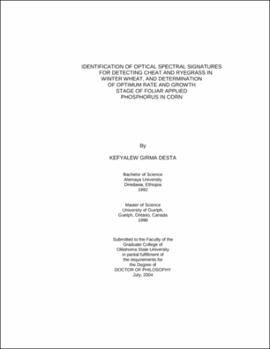| dc.contributor.advisor | Raun, William R. | |
| dc.contributor.author | Desta, Kefyalew Girma | |
| dc.date.accessioned | 2013-12-10T18:04:32Z | |
| dc.date.available | 2013-12-10T18:04:32Z | |
| dc.date.issued | 2004-07 | |
| dc.identifier.uri | https://hdl.handle.net/11244/7723 | |
| dc.description.abstract | Site specific weed management requires the identification of crop and weed species in a mixture. Reflectance spectra were used for the detection of cheat and ryegrass in winter wheat under greenhouse conditions. The three plant species and two nitrogen levels were arranged in a completely randomized design with three replications. Spectral readings were taken at Feekes 3 and 5 wheat growth stages using SD2000 spectrometer. Data were analyzed using a discriminant analysis procedure. The discriminant function with the band combinations 515/675, 555/675 and 805/815 resulted in the best overall correct classification (94%) of observations at Feekes 3 while for spectral data at Feekes 5 the discriminant function with the band combinations 755 and 855/675 resulted in 66.7% overall correct classification of observations. In several instances, ryegrass was classified as either cheat or wheat while cheat was classified as rye. Cheat was not classified as wheat in most of the instances. This suggests that it is possible to identify cheat in wheat using wavelength ratios developed from spectral readings in 10 nm bands between 500 and 860 nm. | |
| dc.description.abstract | Foliar applications of fertilizer phosphorus (P) could improve use efficiency by minimizing soil applications. Nine experiments were conducted at Efaw, Goodwell, Guymon, Lake Carl Blackwell, Perkins and Stillwater, OK in 2002 and 2003 to determine foliar phosphorus rates and appropriate application growth stages. Treatments comprised of ten factorial treatments combinations of three foliar P application timings and four rates of foliar P. Foliar application times were V4, V8 and VT corn growth stages. Foliar P rates were 0, 2, 4 and 8 kg P ha-1. Foliar P applied at VT growth stage improved grain and forage P concentration which was reflected in increased grain yield in some of the experiments. Foliar P rate of 8 kg ha-1 improved to some extent yields and largely forage and grain P concentration of corn more than the smaller rates although phosphorus use efficiency was high only with low foliar P rates. The results suggest that foliar P could be used as efficient P management tool in corn when applied at the appropriate growth stage and rate. | |
| dc.format | application/pdf | |
| dc.language | en_US | |
| dc.rights | Copyright is held by the author who has granted the Oklahoma State University Library the non-exclusive right to share this material in its institutional repository. Contact Digital Library Services at lib-dls@okstate.edu or 405-744-9161 for the permission policy on the use, reproduction or distribution of this material. | |
| dc.title | Identification of optical spectral signatures for detecting cheat and ryegrass in winter wheat, and determination of optimum rate and growth stage of foliar applied phosphorus in corn | |
| dc.contributor.committeeMember | Solie, John B. | |
| dc.contributor.committeeMember | Stone, Marvin L. | |
| dc.contributor.committeeMember | Johnson, Gordon V. | |
| osu.filename | Desta_okstate_0664D_1053.pdf | |
| osu.accesstype | Open Access | |
| dc.type.genre | Dissertation | |
| dc.type.material | Text | |
| dc.subject.keywords | ryegrass | |
| dc.subject.keywords | winter wheat | |
| dc.subject.keywords | phosphorus | |
| dc.subject.keywords | corn | |
| dc.subject.keywords | cheatgrass | |
| dc.subject.keywords | triticum aestivum | |
| dc.subject.keywords | lolium perenne | |
| dc.subject.keywords | bromus tectorum | |
| thesis.degree.discipline | Soil Science | |
| thesis.degree.grantor | Oklahoma State University | |
